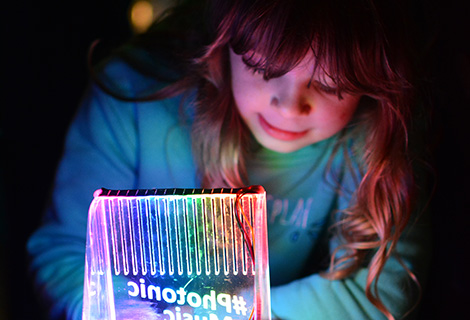Physics and Astronomy researchers at Southampton are bringing science to life through innovative demonstrations and workshops for school children, teachers and the wider public. By explaining the principles behind everyday technologies, they are spreading the word about the importance of fundamental research and inspiring the next generation of scientists, engineers and researchers.
Research challenge and context
Public engagement is an essential part of universities’ work. Done well, it can demystify fundamental scientific research and demonstrate the benefits it brings to people’s daily lives. It can also break down the perception that scientists are unapproachable or exist outside of the ‘real world’ and encourage young people to pursue science at school and as a career.
Modern technologies, such as the smart phone and the internet, should be a key tool in engaging the public with science. However, a lack of understanding of how these technologies work and of the role of fundamental research in their development means they are nowhere near as effective as they could be.

Our solution
Researchers from Physics and Astronomy are delivering a wide-ranging public engagement programme, using the science behind everyday technologies as the springboard for fun, informative activities.
Public engagement programmeThe activities are tailored for different audiences, including primary and secondary school children, teachers and the general public. By including examples of discoveries made at Southampton in the fields of photonics (the physics of light) and microelectronics, they aim to show how fundamental research impacts positively on people’s lives. The activities are presented by the researchers themselves, giving participants the opportunity to meet and talk to scientists, often for the first time.
Activities include The Light Express Roadshow, a series of spectacular laser displays and fascinating visual demonstrations that explore photonics and the science behind the internet. Another programme, Lightwave, delivers hands-on photonics workshops in schools, giving children the opportunity to explore the principles behind internet data transmission and gain an understanding of what researchers really do.
To reach a general public audience, the researchers also exhibit at large-scale science events. In recent years they have had stands at shows such as the Royal Society Summer Science Exhibition and Southampton Science and Engineering Festival, where they demonstrated the Water Transistor. This interactive model uses water to show how transistors (the switches inside modern electronics such as smart phones) work and has become a permanent exhibit at the Winchester Science Centre. Photonics-focused demonstrations and activities at non-science events, such as the ‘Reflecting Photonics’ garden at the Royal Horticultural Society (RHS) Tatton Park Garden Show and ‘The Photon Shop’ at the Light Up Poole! digital arts festival, brought the science behind the internet to audiences that might not otherwise have sought it out.
These activities are rigorously evaluated to measure their effectiveness, for example through paper-based and online participant surveys.
What was the impact?
Between 2014 and 2019, the researchers engaged with more than 46,000 people who participated in shows, workshop and demonstrations, and a further 75,000 visitors to the Winchester Science Centre engaged with the Water Transistor exhibit. For over 10,400 people, these activities made a measurable difference to their understanding of modern technologies and how scientific research has improved their daily lives.
The activities increased the number of people, particularly school-age children, who understand that physics research has led to the smart phone and that research into optical fibres and lasers has led to the internet. Importantly, taking part in engagement activities also increased the number of school students who are inclined to study a science, technology, engineering or maths (STEM) subject. The majority of participating schools were those with a high proportion of students from groups that are currently underrepresented in STEM higher education and related careers, such as low socio-economic groups.
Feedback shows how the activities enthused and informed participants:
“Great inspiration for upcoming physicists. Gave a broader idea to why we need to keep researching to improve the current technology.” Attendee at Light Express show for teachers
"I didn't know how much data could be transported in a fibre optic!" The Light Express Roadshow participant (general public)
“[I learned] light travels in straight lines but we can persuade it to bend.” Nine-year-old visitor to stand at RHS Tatton Park Garden Show
In addition, interest from print and broadcast media has taken science topics to an even wider domain. For example, the ‘Reflecting Photonics’ garden, along with an explanation of how the internet works, was featured on Gardener’s World and RHS Flower Show Tatton Park, reaching 4.45 million viewers. Light Express demonstrations were used on the BBC4 TV programme The Secret Story of Stuff: Materials of the Modern Age, watched by an estimated 0.4 million viewers.
Find out more
Talk to our research team and find out more about this work. Professor David Smith, Dr Pearl John and Jo Corsi led the research on this project.